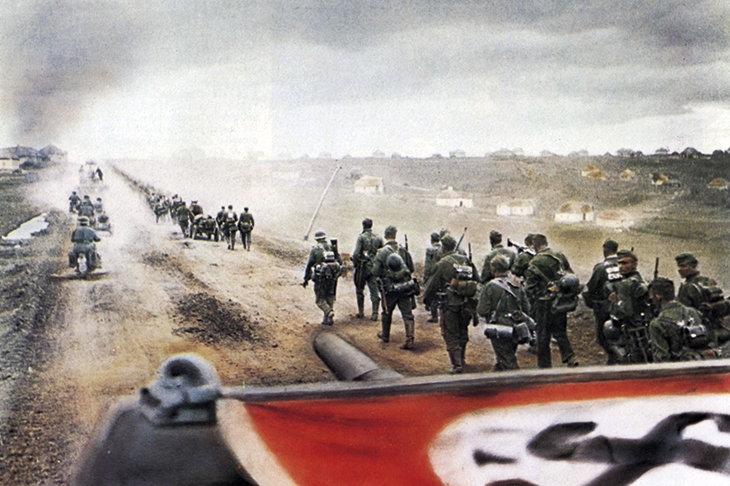The most extraordinary thing, still, about Operation Barbarossa is the complete surprise the Wehrmacht achieved. In the early hours of 22 June 1941 the largest invasion force in history, ultimately some three million men, struck at the Soviet Union on a front of nearly 2,000 miles. When Stalin was woken with the news, he wouldn’t believe it. It couldn’t be Hitler’s doing, he insisted; surely just sabre-rattling by Wehrmacht generals? Hours passed before he would accept his calamitous misjudgments and issue a general order to fight back by every means.
Hitler’s strategic challenge in the late 1930s had been essentially the same as the Kaiser’s in 1914: how to make war simultaneously on two fronts. The Kaiser, thanks to a theoretical plan conceived 20 years earlier by the chief of the Grosser Generalstab, Alfred von Schlieffen, ‘solved’ the problem by tactics inspired by the Battle of Cannae, in which Hannibal annihilated a superior Roman army by encirclement, and Napoleon’s ‘strategy of the central position’, designed to defeat two cooperating armies by concentrating force against one of them till it yielded, then turning to face the other. Schlieffen’s plan entailed a holding operation on the Russian front while sending the bulk of the imperial German army through neutral Belgium to encircle the French. Thereafter the victorious army would entrain for east Prussia to deal with the slower-mobilising Russians. With such brilliant officers as there were on the General Staff in 1914, what could possibly go wrong?
But this elevated battlefield tactics to the level of strategy. One of Hitler’s best field marshals, Albert Kesselring, said the Kaiser’s staff disdained ‘anything to do with oil which soiled the fingers and hampered the tactician and strategist in the free flight of his ideas’.
Stalin dismissed repeated warnings of Germany’s impending attack as fantasies or provocations
Hitler knew he was cleverer than Schlieffen. He would sequence his moves better, retaining the initiative absolutely. Instead of fighting a hostage-to-fortune holding operation in the east, he’d arrange a non-aggression pact with the Soviet Union, leaving him free to defeat Britain and France when he chose, after which, when the time was right, he’d ignore the pact and turn his military attention east. Indeed, a pact would even allow him to occupy half of Poland, advancing his start-line towards the Soviet Union some 200 miles. With such a presiding genius, what could possibly go wrong?
To explain the whole complex story, Jonathan Dimbleby begins with the shock of the Rapallo Treaty of 1922, by which Germany and the Soviet Union established close relations. Rapallo enraged Lloyd George, for it scuppered his plans for European reconstruction, which he’d intended to seal at the conference in nearby Genoa at the very time the treaty was being secretly negotiated. It was the beginning of Whitehall’s chronic mistrust of both Berlin and Moscow, the latter most of all. Dimbleby tracks with dismay the Foreign Office’s aversion to any accommodation with Moscow (ministers’ aversion too; mercifully, he’s no rehabilitator of Chamberlain), even once the Nazi threat was manifest.
After the Munich Agreement in 1938, which Stalin denounced, an Anglo-French-Soviet alliance was out of the question. The Molotov-Ribbentrop Pact followed, which only confirmed Whitehall’s view that the two dictators were hand in glove. When the Soviets invaded Finland in December 1939, the Foreign Office wanted to send troops to aid the Finns, arguing that ‘the complete downfall of Russian military power’ was to Britain’s advantage: ‘The collapse of Russia was likely to contribute materially to the early defeat of Germany.’ Dimbleby wonders how bureaucrats drew this ‘bizarre conclusion’. In fact, it’s perfectly clear if you follow the FO’s logic (as far as it went), that ‘the Soviets had settled down into an undeclared war’ against Britain, partners in crime with the Nazis who thereby gained access to Russia’s strategic raw materials. Fortunately, Churchill had long seen the essential ambivalence in the Pact and was ready for its sudden collapse, which was more than Stalin was, or indeed the Red Army, whose leadership he’d extensively purged three years earlier.
Stalin dismissed warnings from Churchill (who had the benefit of Ultra) that the Germans were massing for an offensive. Warnings from Stalin’s own agents were also dismissed as fantasies or provocations. Six days before the invasion, an officer in the German air ministry whom the NKVD had recruited in 1940, codename ‘Starshina’ (which Dimbleby translates infelicitously as ‘Corporal’), warned that attack was imminent. Stalin scribbled on the report: ‘Tell the source… to go fuck his mother! This is no source but a disinformer.’ Dimbleby quotes Solzhenitsyn: Stalin didn’t trust his own mother, God, fellow party members, peasants, workers, intellectuals, soldiers, relatives, wives, mistresses or even his own children. ‘In all his long suspicion-ridden life he had only trusted one man… This man whom Stalin trusted was Adolf Hitler.’
With his impressive team of researchers, advisers and editors, Dimbleby tells the story of strategic miscalculation and (self-) deception on all sides, and then Hitler’s ‘war of extermination’, magnificently.
It is Stewart Binns’s misfortune perhaps that another and nominatively more celebrated former BBC man should simultaneously bring out a book with the same title. But in Binns’s Barbarossa, the invasion is merely the first phase of the Soviets’ war as a whole, in which the psyche of the Russian people, with whom he clearly has a close affinity, is key — so not just Barbarossa, but Stalingrad, the counter-offensives of 1943, the long slog to Berlin and the aftermath, which he relates with clarity and humanity. The Red Army, according to Binns, aren’t all rapists, but the loot found in Marshal Zhukov’s dacha in one of Stalin’s post-war witch hunts does the image of the hero of the Great Patriotic War no good. Perhaps, though, the man who saved Stalin from his folly in June 1941 might be excused his 20 Holland and Holland shotguns, the huge canvas of nudes over his bed and the rest of the seven waggons of plunder he’d transported back toMoscow. Stalin confiscated it, but spared Zhukov the gulags.
Both these Barbarossas read wonderfully well.






Comments